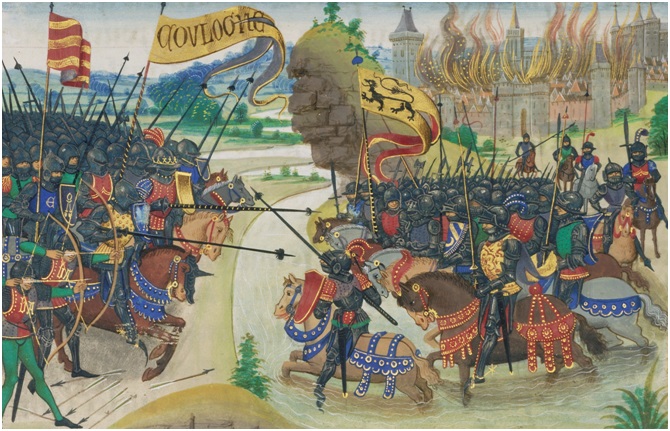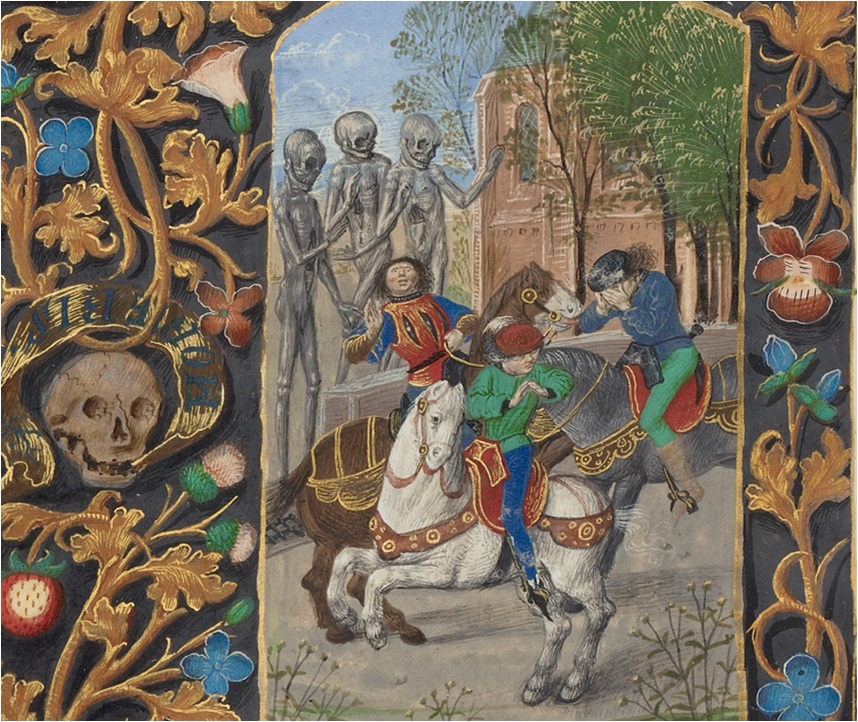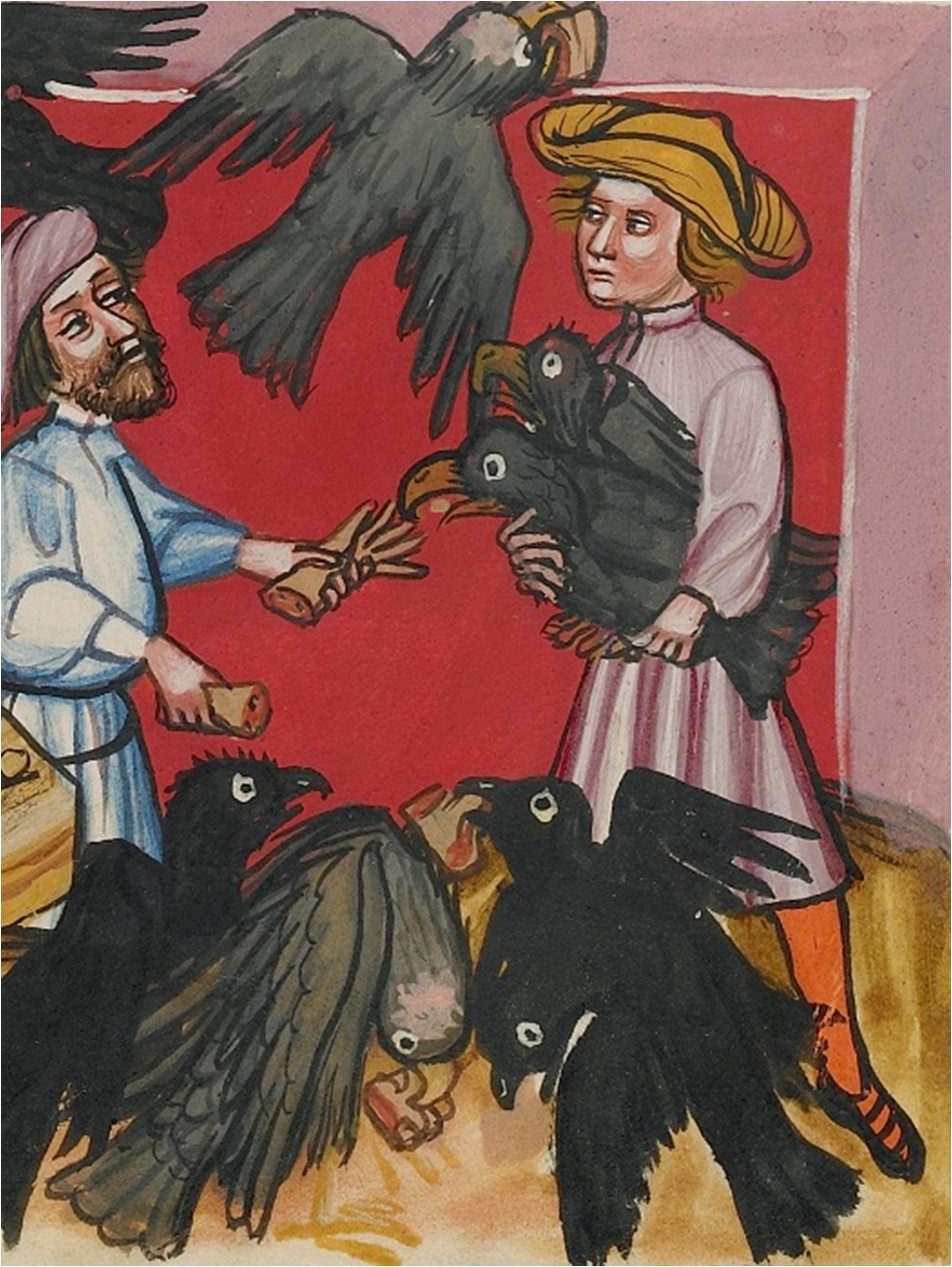As season 4 of Game of Thrones hits the half-way point, we share visual predictions for rest of the season—in medieval manuscript form

Job Pointing to a Corpse on the Ground in a Book of Hours, about 1410, Follower of the Egerton Master. Tempera colors, gold leaf, gold paint, and ink on parchment, 7 ½ x 5 ½ in. (19.1 x 14 cm). The J. Paul Getty Museum, Ms. Ludwig IX 5, fol. 147
Winter is coming. All men must die. And Game of Thrones has reached mid-season!
The phrase “All men must die”—or Valar morghulis in High Valyrian, the language of highborns in Game of Thrones—is a reminder of the fleeting nature of life. This theme is constantly played out in the HBO series as kings rise and fall from power, family lineages are severed, and slaves rise up against masters. In the image above, the Old Testament figure of Job points to a corpse and asks for God’s comfort with the following words, which medieval Christians would have recited as a prayer while viewing the illumination:
“Waters wear away the stones, and with inundation the ground by little and little is washed away: so in like manner thou shalt destroy man. Thou hast strengthened him for a little while, that he may pass away forever: thou shalt change his face, and shalt send him away… His flesh, while he shall live, shall have pain, and his soul shall mourn over him.” (Job 14:19, 20, 22)
In other words, Valar morghulis.
TV Guide, Medieval Edition
Each week we’ve been unpacking Sunday’s episodes through medieval masterpieces on the Getty Tumblr. Some of the events in Game of Thrones are modern medievalisms, appearing to have jumped right off the pages of illuminated manuscripts. Other moments relate metaphorically to the medieval imagination and spirituality: wild races living at the extremes of known geography, fire-breathing dragons, devotional practices directed toward the divine. Murder, torture, lust, deceit, and merciless justice are given much screen time, perhaps because they are themes as old as human history and they appeal to our darker side.
My Predictions, in Artwork Form
Since we’ve had so much fun unpacking episodes through medieval images (and matching manuscripts to characters), we thought we’d work the other way and use manuscripts to predict the future of Game of Thrones.
Looking into our artistic crystal ball, what can we expect for the rest of the season? Here are nine predictions encrypted in miniatures from a range of manuscripts in the Getty’s collection: apocalypse, chronicle, history, saint’s life, prayer book, fighting manual, romance, and Psalter.
1. Bow Before the Dragon

The Adoration of the Beast in the Getty Apocalypse, about 1255–60. Tempera colors, gold leaf, colored washes, pen and ink on parchment, 12 9/16 x 8 7/8 in. (31.9 x 22.5 cm). The J. Paul Getty Museum, Ms. Ludwig III 1, fol. 24
2. A Young Boy Becomes King

The Coronation of Pepin in History of Charles Martel, written 1463–65, illuminated 1467–72, Loyset Liédet and Pol Fruit. Tempera colors, gold leaf, and gold paint on parchment, 9 x 7 7/16 in. (22.9 x 18.9 cm). The J. Paul Getty Museum, Ms. Ludwig XIII 6, leaf 7v
3. The Wild Ones

Akephalos and Knyokephalos in Mirror of History, about 1474. Tempera colors, gold leaf, and ink on parchment, 17 ¼ x 12 in. (43.8 x 30.5 cm). The J. Paul Getty Museum, Ms. Ludwig XIII 5, vol. 1, fol. 67v; Initial P: The Ship of Bishop Theophilus Sailing Near an Island Inhabited by Wild Men in The Discovery and Translation of the Body of Saint Anthony, about 1465–70, Master of the Brussels Romuléon. Tempera colors, gold leaf, and ink on parchment, 9 ¼ x 6 15/16 in. (24.8 x 17.6 cm). The J. Paul Getty Museum, Ms. Ludwig XI 8, fol. 42
4. A Fishy Resurrection from a Stony Grave

The Raising of Lazarus in the Prayer Book of Cardinal Albrecht of Brandenburg, about 1525–30, Simon Bening. Tempera colors, gold leaf, gold paint, and ink on parchment, 6 5/8 x 4 ½ in. (16.8 x 11.4 cm). The J. Paul Getty Museum, Ms. Ludwig IX 19, fol. 69v
5. A Mountain and a Viper

Combat with Lance in Flower of Battle by Fiore Furlan dei Liberi da Premariacco, about 1410. Tempera colors, gold leaf, silver leaf, and ink on parchment, 11 x 8 1/8 in. (27.9 x 20.6 cm). The J. Paul Getty Museum, Ms. Ludwig XV 13, fol. 39v
6. Unite or Be Vanquished

The Conquest of Gasgogne by the Armies of Luxembourg, Boulogne, and Artois in History of Charles Martel, written 1463–65, illuminated 1467–72, Loyset Liédet and Pol Fruit. Tempera colors, gold leaf, and gold paint on parchment, 9 x 7 7/16 in. (22.9 x 18.9 cm). The J. Paul Getty Museum, Ms. Ludwig XIII 6, leaf 7v
7. Cause and Effect

A Woman Meeting with Her Lover while Her Husband Sleeps in Romance of the Rose, about 1405. Tempera colors, gold leaf, and ink on parchment, 14 7/16 x 10 ¼ in. (36.7 x 26 cm). The J. Paul Getty Museum, Ms. Ludwig XV 7, fol. 91v; Initial E: An Archer Fitting an Arrow into His Bow in the Bute Psalter, about 1270–80, Bute Master. Tempera colors, gold, and ink on parchment, 6 11/16 x 4 11/16 in. (17 x 11.9 cm). The J. Paul Getty Museum, Ms. 46, fol. 84
8. Walking Death

The Three Living and the Three Dead in the Crohin-La Fontaine Hours, about 1480–85?, Master of the Dresden Prayer Book. Tempera colors, gold paint, and ink on parchment, 5 ¼ x 3 11/16 in. (20.5 x 14.8 cm). The J. Paul Getty Museum, Ms. 23, fol. 146v
9. A Feast for Crows

Evilmerodach Ordering the Murder of His Father Nebuchadnezzar in World Chronicle, about 1400-1410. Tempera colors, gold and silver paint, and ink on parchment, 13 13/16 x 9 ¼ in. (33.5 x 23.5 cm). The J. Paul Getty Museum, Ms. 33, fol. 217
What’s your prediction for the end of the season? Browse our manuscripts collection and share your favorite image(s) with us on Twitter (@thegetty), Tumblr, or in the comments below!




Amazing, can’t wait to see what happens the next episode!